As the only contact point between you and the road, your tyres are one of the most important components on your bicycle. However, because road bike tyres generally look so similar, it’s not always easy to spot the difference between a good tyre and a bad tyre.
Upgrading your bike’s stock tyres to something better, whether that be in terms of greater volume, decreased rolling resistance, improved cornering grip or simply increased puncture protection, can transform your riding experience.
The good news is this – compared to other bike parts, getting the best road bike tyres needn’t cost the earth.
Every tyre on this list has an RRP of around £70 or less per tyre, and can most often be found at a discount. That's not a trivial amount of money but, as a component that has a significant impact on how your bike rides, it's a relatively cheap upgrade for your road bike.
However, the choice of road bike tyres available on the market can be a little overwhelming. The devil really is in the detail, so we’ve put our team of expert testers to the task, logging thousands of kilometres – and even spending time in a lab – to find the best road bike tyres available.
The tyres in this list are aimed at summer racing and training, prioritising low rolling resistance. If you're looking for something more durable for the winter and shoulder seasons, check out our best winter road bike tyres guide.
We've also put together a guide at the end of this article explaining everything you need to know about road bike tyres.
Editor's note: this list of the best road bike tyres was updated on 11 March 2025, when we removed models that are no longer in production.
Best road bike tyres in 2025, as rated by our expert testers
Continental Grand Prix 5000 S TR
SQUIRREL_TEXT_13097799
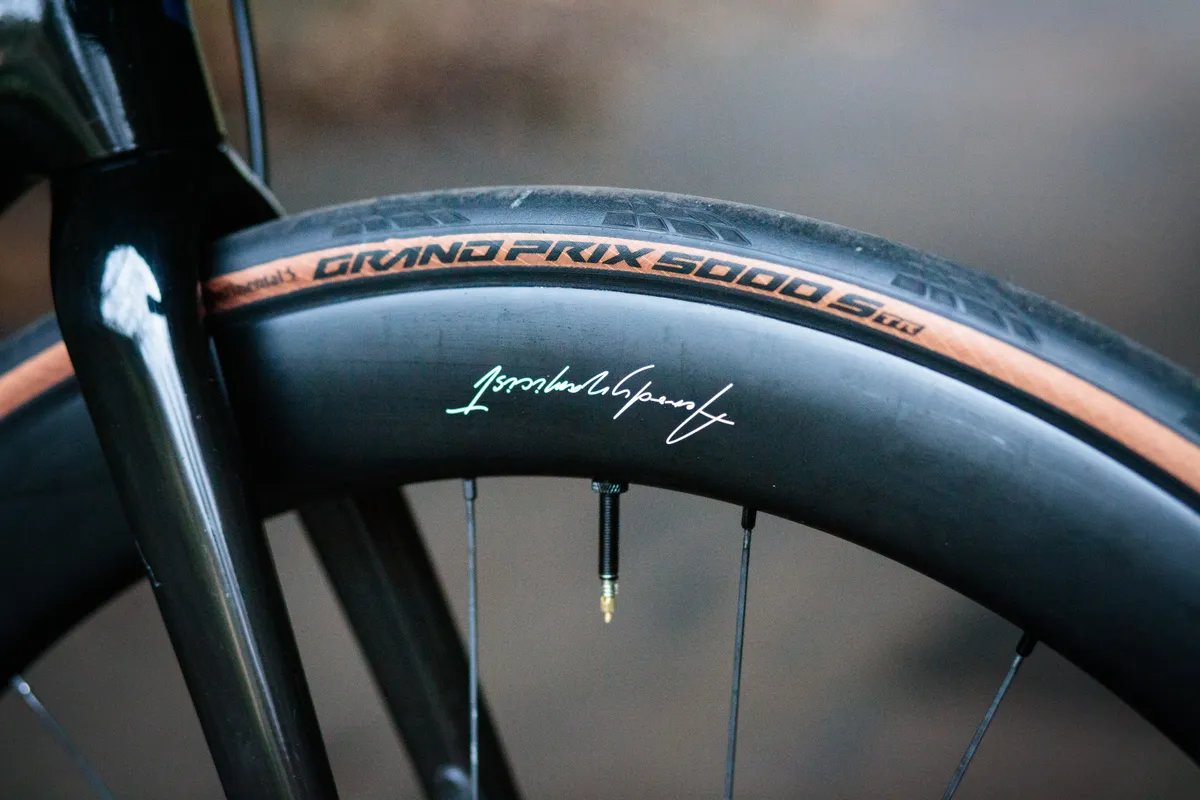
- £69.95 / $98.95 / €79.90 as tested
- Pros: Fast-rolling; good compatibility; robust
- Cons: "20 per cent faster" claim appears unfounded
The Continental Grand Prix 5000 S TR arrived as the replacement for the German brand's previous road tubeless tyre, the GP5000 TL.
In short, it's a fast, grippy and lightweight tubeless tyre. It's also compatible with hookless rims – a first for Conti's road tubeless tyres – and robust enough for Paris-Roubaix, with the tyre launched on the back of Sonny Colbrelli’s win at the 2021 edition of Paris-Roubaix.
It's available in a range of sizes, too, with 25mm, 28mm, 30mm and 32mm options.
Specs
Type Tubeless-ready | Colour options Black or 'transparent' tan | Size and width options 700x25c, 700x28c, 700x30c, 700x32c | Size tested 700x28c | Weight 280g | TPI 220
SQUIRREL_13097799
Continental Grand Prix 5000 Clincher
SQUIRREL_TEXT_13079739
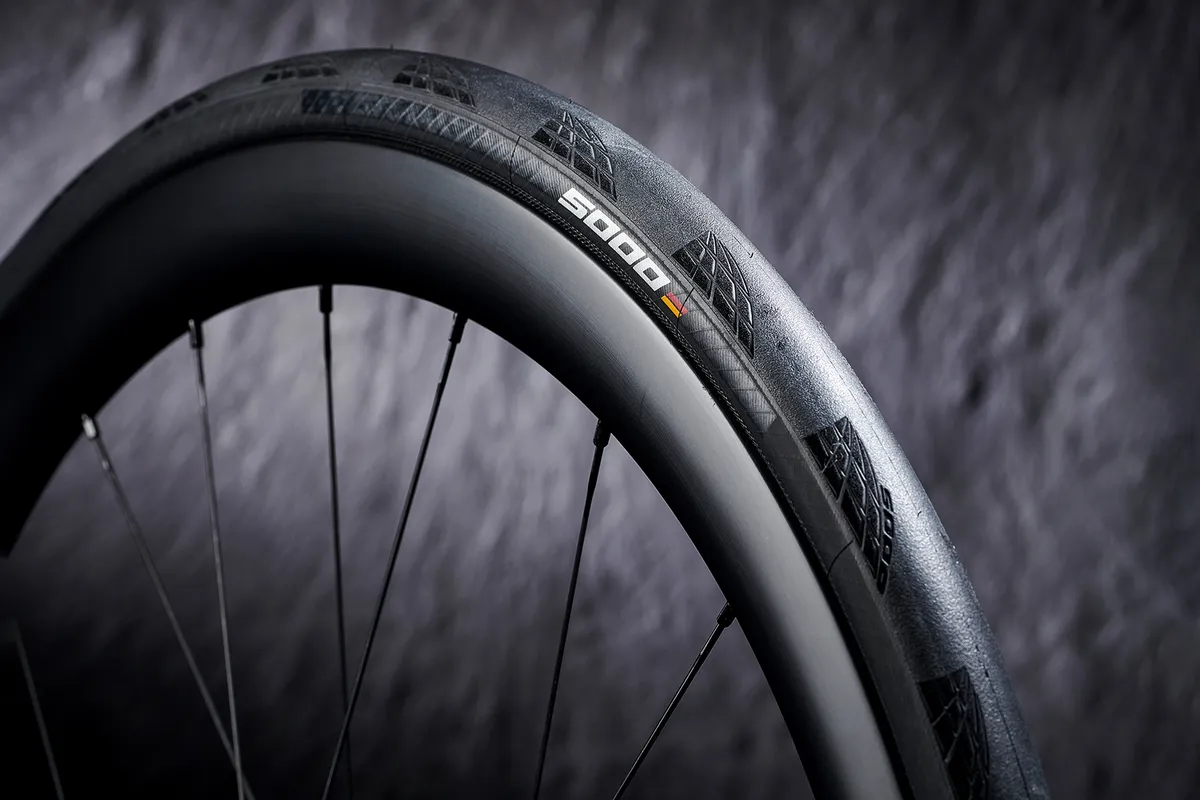
- £60 / $78 / €72 / AU$108 as tested
- Pros: Superb ride feel; impressive and predictable grip; durable
- Cons: Pricey
The Grand Prix (GP) 5000 arrived as the replacement for Continental's popular GP 4000 clincher.
While the Grand Prix 5000 S TR is now the flagship, tubeless-ready tyre in the range, the GP 5000 Clincher remains one of the best all-round road bike tyres for use with inner tubes.
It offers a claimed 12 per cent reduction in rolling resistance over the previous-generation tyre, without sacrificing the GP 4000’s low wear rate.
There’s a new pattern on the sides of the tread, making for fast, confident cornering. It’s another tyre that handles rougher roads well, with a supple feel, thanks to a thinner casing, and there's a Vectran puncture protection belt, too.
Specs
Type Clincher | Colour options Black or 'transparent' tan | Size and width options 700x23c, 700x25c, 700x28c, 700x32c | Size tested 700x28c | Weight 241g | TPI 330
SQUIRREL_13079739
Hutchinson Blackbird Racing Lab TLR
SQUIRREL_TEXT_13164269

- £62 / €70 as tested
- Pros: Fast-feeling; easy installation; well-priced
- Cons: Lacks larger sizing options
The Blackbird Racing Lab TLR challenges the best tyres on the market with impressive ride feel, excellent grip and low rolling resistance, all at a competitive price.
Our tester found them easy to install and enjoyed their zippy nature.
Greater widths would be welcomed though.
Specs
Type Clincher | Colour options Black or tan | Size and width options 700x26c, 700x28c, 700x30c | Size tested 700x28c | Weight 283g | TPI 127
SQUIRREL_13164269
SQUIRREL_13096244
Pirelli P Zero Race TLR
SQUIRREL_TEXT_13087033
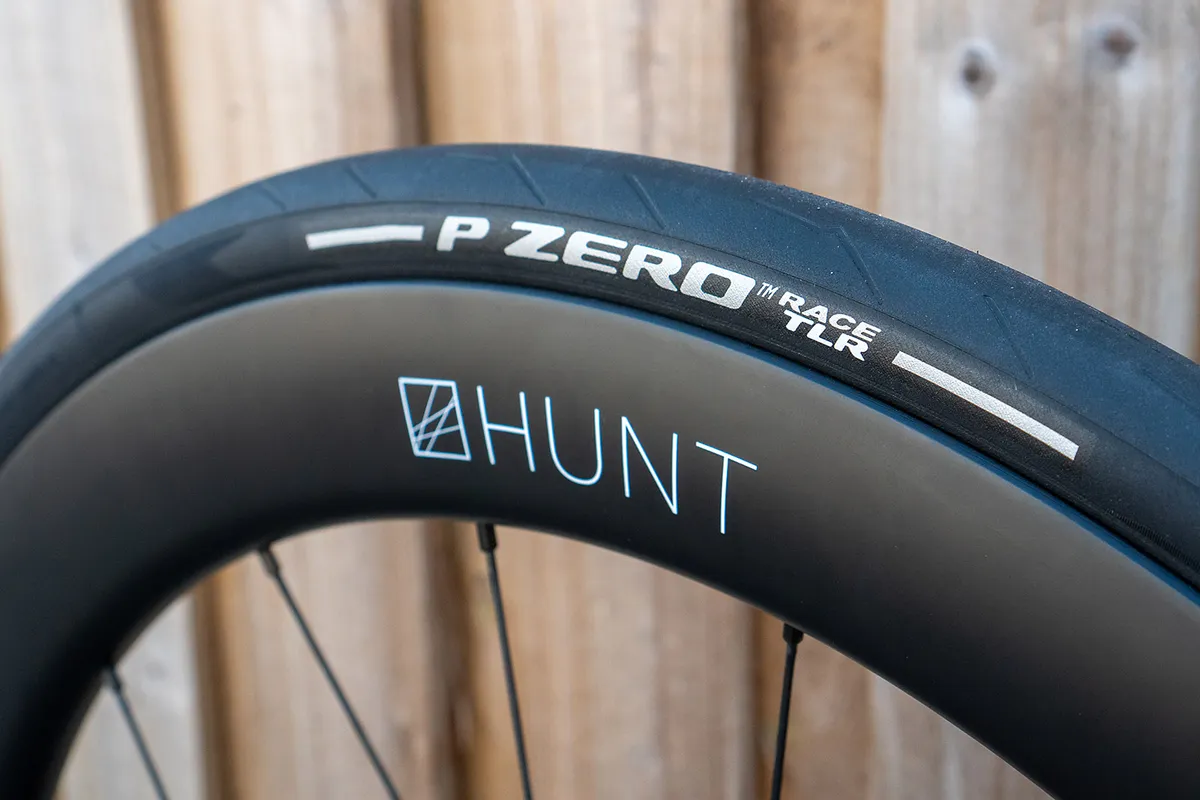
- £78.99 / $99.90 / €84.90 / AU$139.90 as tested
- Pros: Good speed and ride quality; best-on-test rolling resistance; easy to fit
- Cons: Quite narrow and round shape
Pirelli’s P Zero Race TLR was already one of our favourites, but the Speedcore update (released in spring 2023) has elevated its performance to even higher levels.
The P Zero Race TLR was the top-performing tyre in our recent rolling resistance lab test and it backs up its speed with excellent real-world performance, good ride feel and easy tubeless setup.
It sized up slightly smaller than expected on our test rims and isn’t the lightest tyre in its class, but it otherwise impresses across the board.
Specs
Type Tubeless (tested) or clincher | Colour options Black (with grey, white, yellow or red logos) or classic tan | Size and width options 700x26c, 700x28c, 700x30c, 700x32c, 700x35c, 700x40c | Size tested 700x28c | Weight 310g | TPI 120
SQUIRREL_13087033
Goodyear Eagle F1 R Tubeless
SQUIRREL_TEXT_13087032
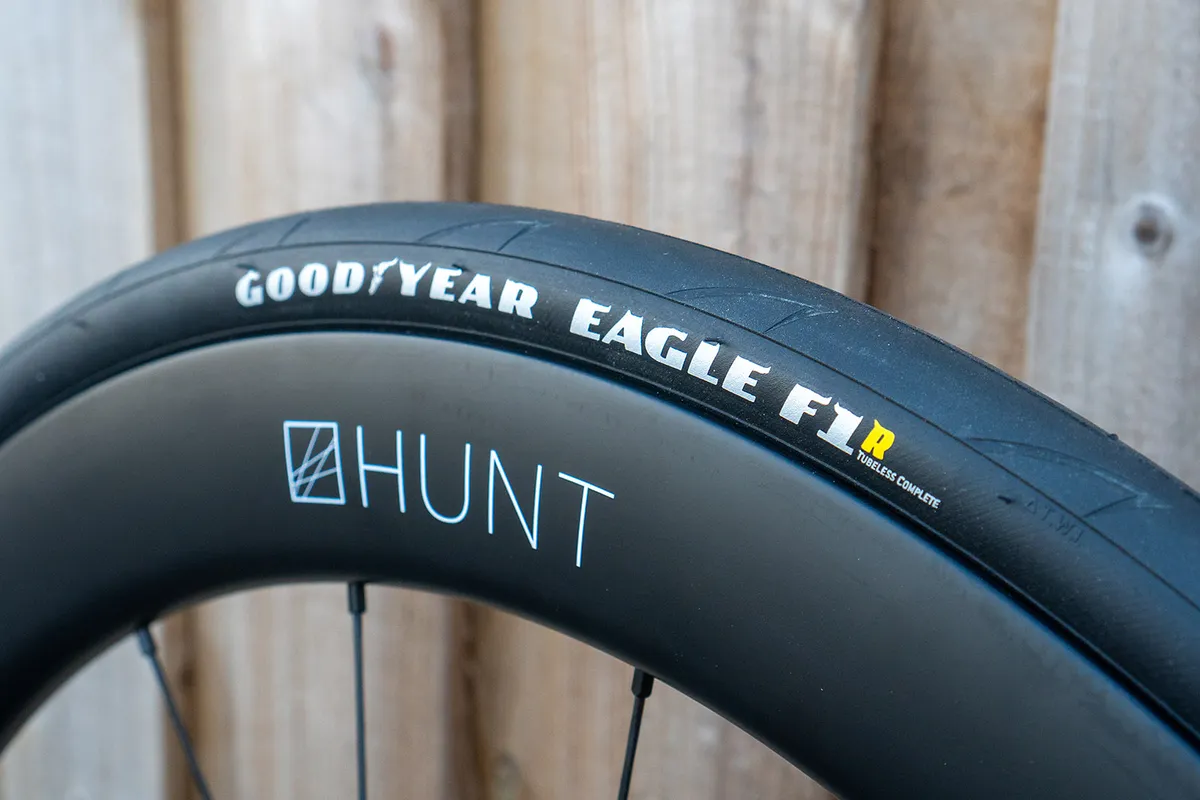
- £65 / $80 / €70 as tested
- Pros: Smooth and supple ride; competitive rolling resistance; good value
- Cons: Slightly dull-feeling compared to the best
The recently updated Eagle F1 R is Goodyear’s all-round road racing tyre, with a considered balance between speed, durability and puncture protection.
With an updated casing and compound compared to its highly rated predecessor, the Eagle F1 R doesn’t disappoint.
It’s competitively fast, easy to set up and impressed our tester with excellent ride feel and grip out in the real world. The tyre is relatively portly, but the trade-off is a highly competitive price for its class.
Specs
Type Tubeless (tested) or clincher | Colour options Black or tan | Size and width options 700x25c, 700x28c, 700x30c, 700x32c, 700x34c | Size tested 700x28c | Weight 313g | TPI 120
SQUIRREL_13087032
Cadex Race
SQUIRREL_TEXT_13092828
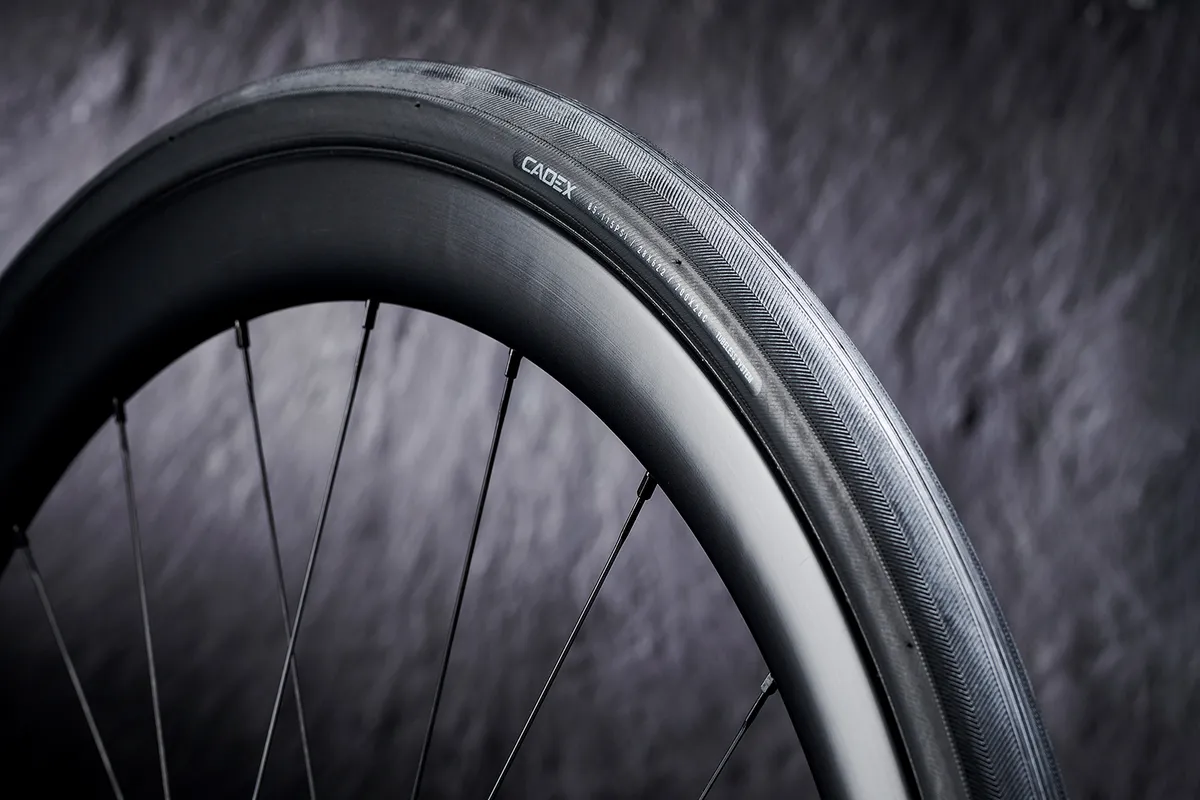
- £65 / $100 / €80 / AU$125 as tested
- Pros: Fast-rolling tyre for all-around performance; easy installation; minimal air loss
- Cons: Not the lightest
This tyre from Giant’s performance component brand, Cadex, is tubeless-only. There’s a single-layer 170 TPI casing to up rolling speed and suppleness, and proprietary puncture protection and rubber compound.
Tubeless setup was easy, needing just a floor pump and a single tyre lever to ease the bead over the rim. The tight seal led to minimal air loss over a week.
The Cadex Race copes well with rougher road surfaces and there’s a feeling of easy speed. There’s good support at lower pressures and predictable handling, but they are slightly heavier than other options.
Specs
Type Tubeless | Colour options Black | Size and width options 700x25c, 700x28c | Size tested 700x28c | Weight 331g | TPI 170
SQUIRREL_13092828
Hutchinson Challenger Tubeless
SQUIRREL_TEXT_13080078
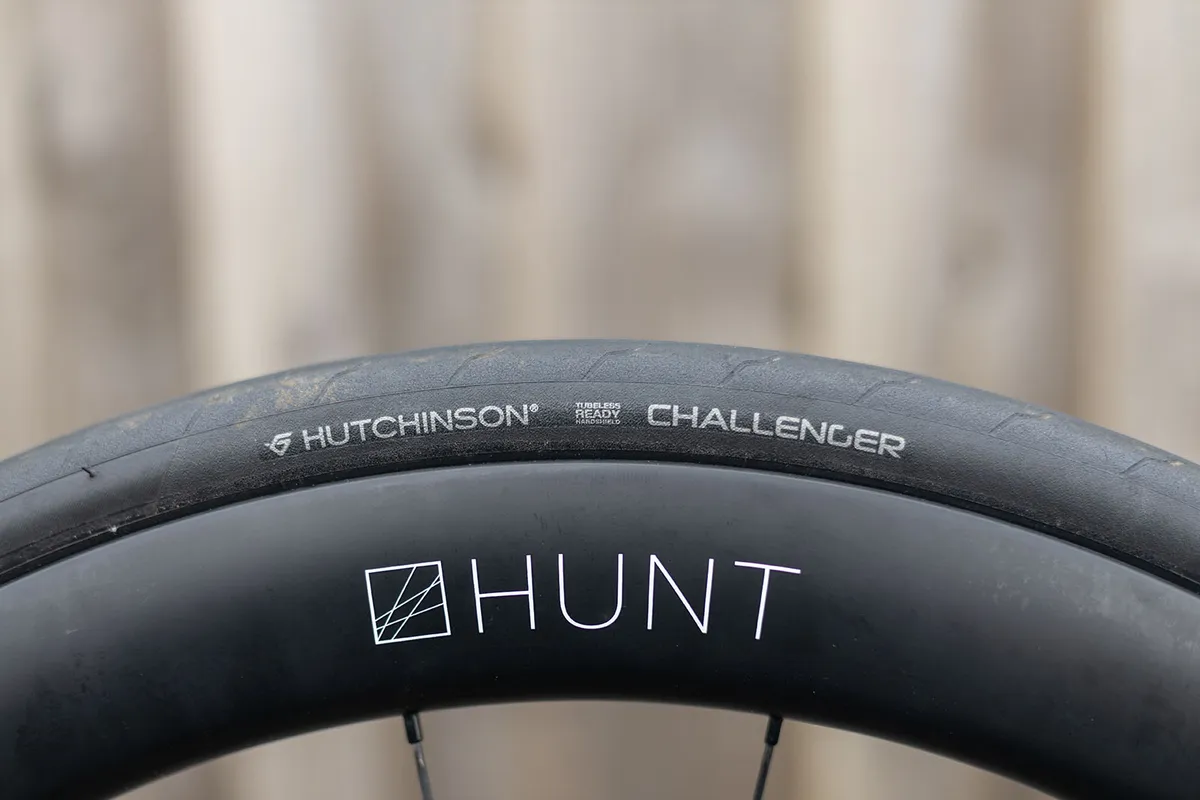
- £60 / €60 as tested
- Pros: Great puncture resistance; good longevity; well-priced
- Cons: Sealant-free claims are unrealistic
The Hutchinson Challenger Tubeless impressed us with its all-year-around ability and low wear rate.
Our tester found them to balance excellent performance and reliability out on the roads while not breaking the bank.
While the tyres can be run sealant-free, you lose the system's puncture-preventing benefits.
Specs
Type Tubeless | Colour options Black | Size and width options 700x25c, 700x28c, 700x32c | Size tested 700x28c | Weight 396g | TPI 127
SQUIRREL_13080078
Michelin Power Cup TLR
SQUIRREL_TEXT_13118974
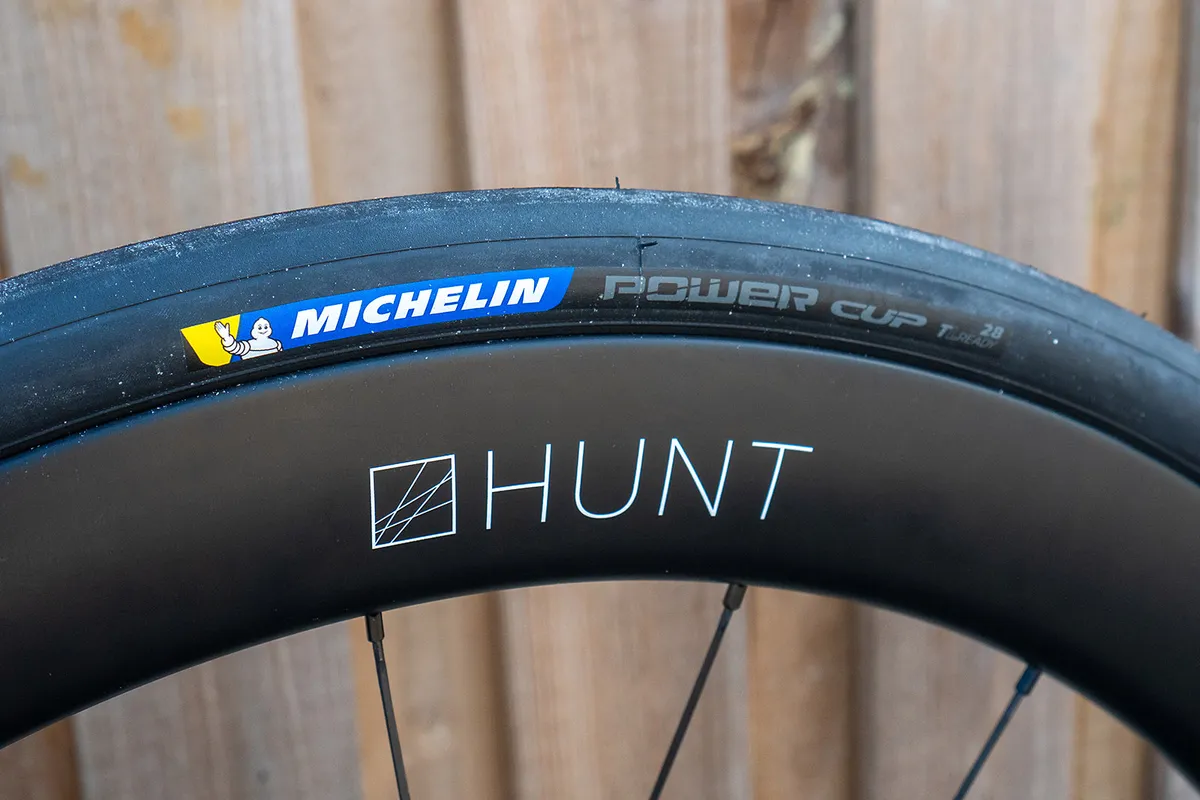
- £69.99 / $79.99 / €79.99 as tested
- Pros: Competitively low rolling resistance with a good ride feel; lightweight; well-priced
- Cons: Air leakage
The Power Cup TLR is Michelin’s only tubeless option for road bikes, but thankfully it’s a very good one.
With a 4x120 TPI casing and a MotoGP-inspired rubber compound, the Michelin Power Cup TLR delivered excellent performance in both our lab and real-world testing.
At 278g, it’s competitively light and the flexible casings made installation notably easy.
Relatively high air leakage means you’ll need to be willing to pump these tyres up before every ride, but if you can live with that then there’s a lot to like here – especially at this price.
Specs
Type Tubeless (tested) or clincher | Colour options Black or tan | Size and width options 700x25c, 700x28c, 700x30c | Size tested 700x28c | Weight 278g | TPI 120
SQUIRREL_13118974
Panaracer Agilest TLR
SQUIRREL_TEXT_13086878
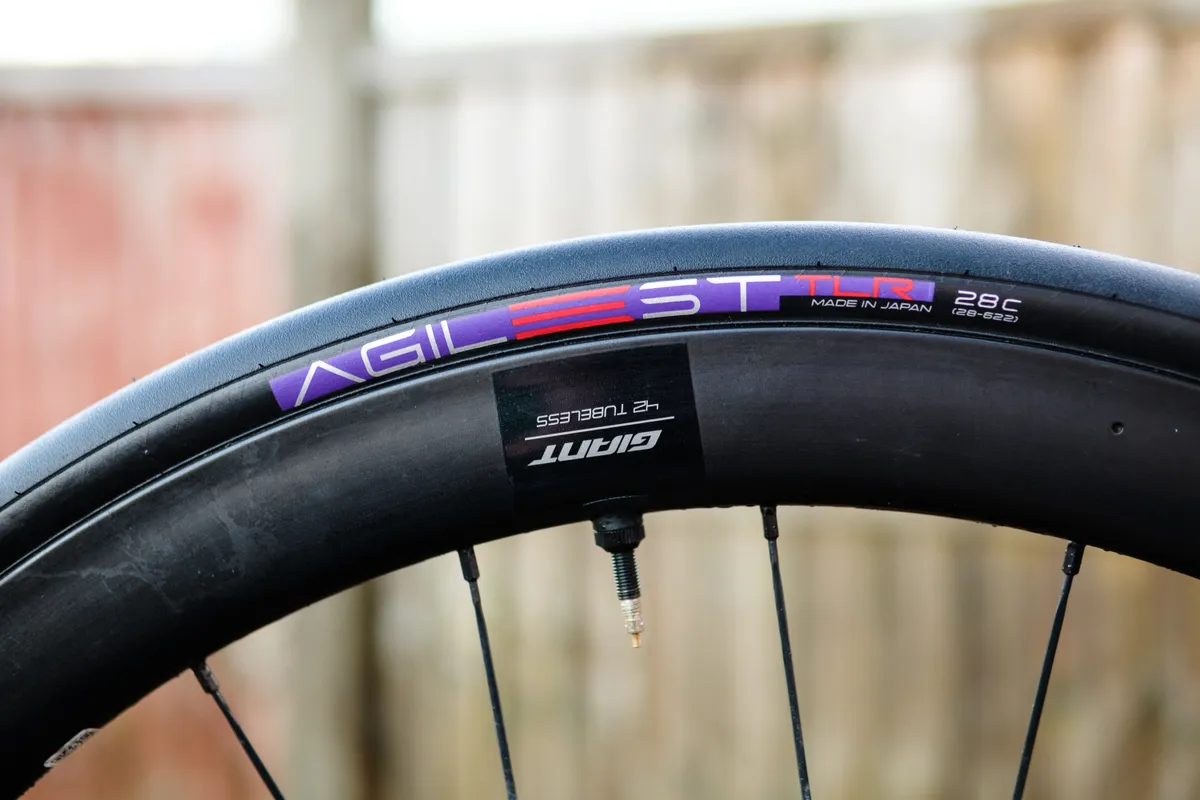
- £60 / $80 as tested
- Pros: Lightweight and fast; supple ride feel; easy to install
- Cons: No puncture protection belt
The Panaracer Agilest is a svelte, tubeless-ready road bike tyre. Rolling resistance is low and compliance is ample thanks to its sleek tread and reasonably high thread count.
The absence of a puncture protection belt augments comfort, but increases the risk of flats on harsher roads.
The Agilest comes in three sizes, but the sole tubeless colour option is black with purple and red lettering. Only the clincher version is available in tanwall.
Specs
Type Tubeless | Colour options Black | Size and width options 700x25c, 700x28c, 700x30c | Size tested 700x28c | Weight 243g | TPI 120
SQUIRREL_13086878
Schwalbe One TLE
SQUIRREL_TEXT_13149664
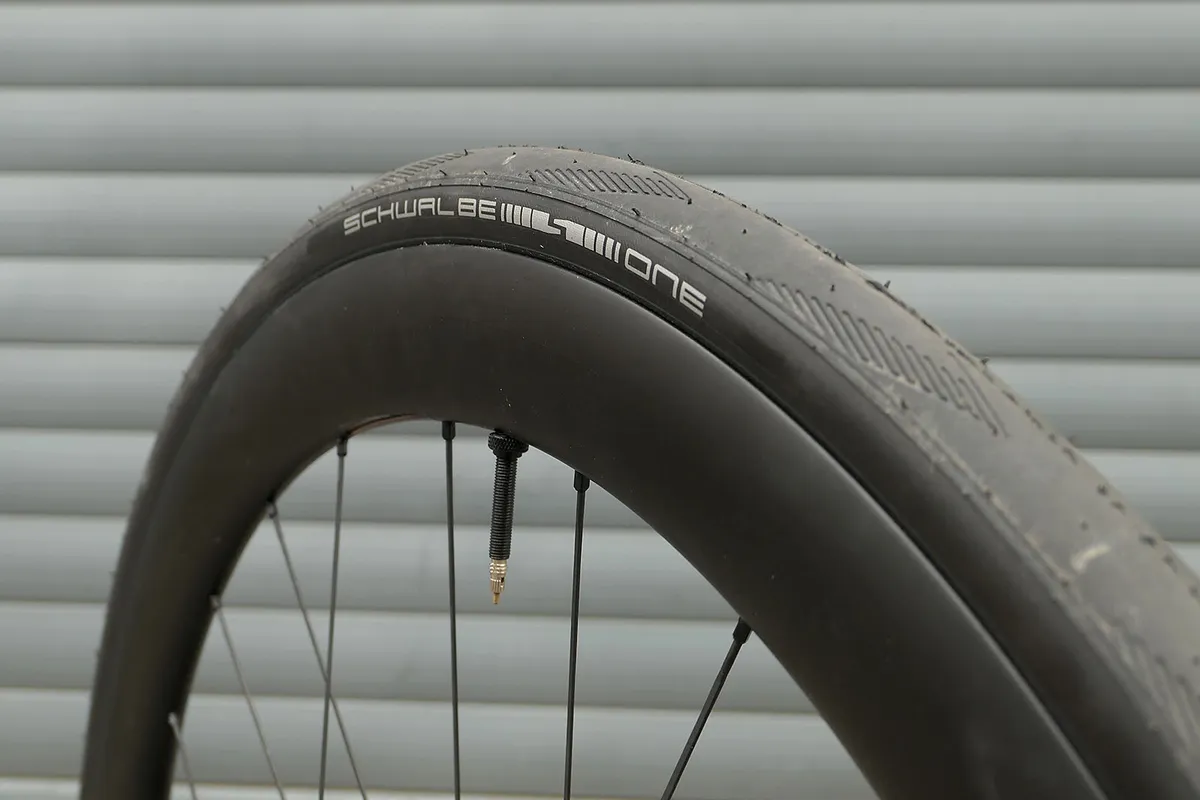
- £62 / $68 as tested
- Pros: Great all-weather grip; hookless-compatible; easy installation
- Cons: Heavier than claimed; harsh casing
The Schwalbe One TLE is a great all-season training tyre, offering plentiful grip in the wet.
We found the tyre to be durable, with a low wear rate adding to longevity.
They're not the fastest tyres and they came in heavier than claimed, but they remain competitive against other road tyres at their price point.
Specs
Type Clincher | Colour options Black or tan | Size and width options 700 x 25c, 700 x 28c, 700 x 30c, 700 x 32c | Size tested 700x28c | Weight 362g | TPI 67
SQUIRREL_13149664
Specialized S-Works Turbo 2BR
SQUIRREL_TEXT_13082216
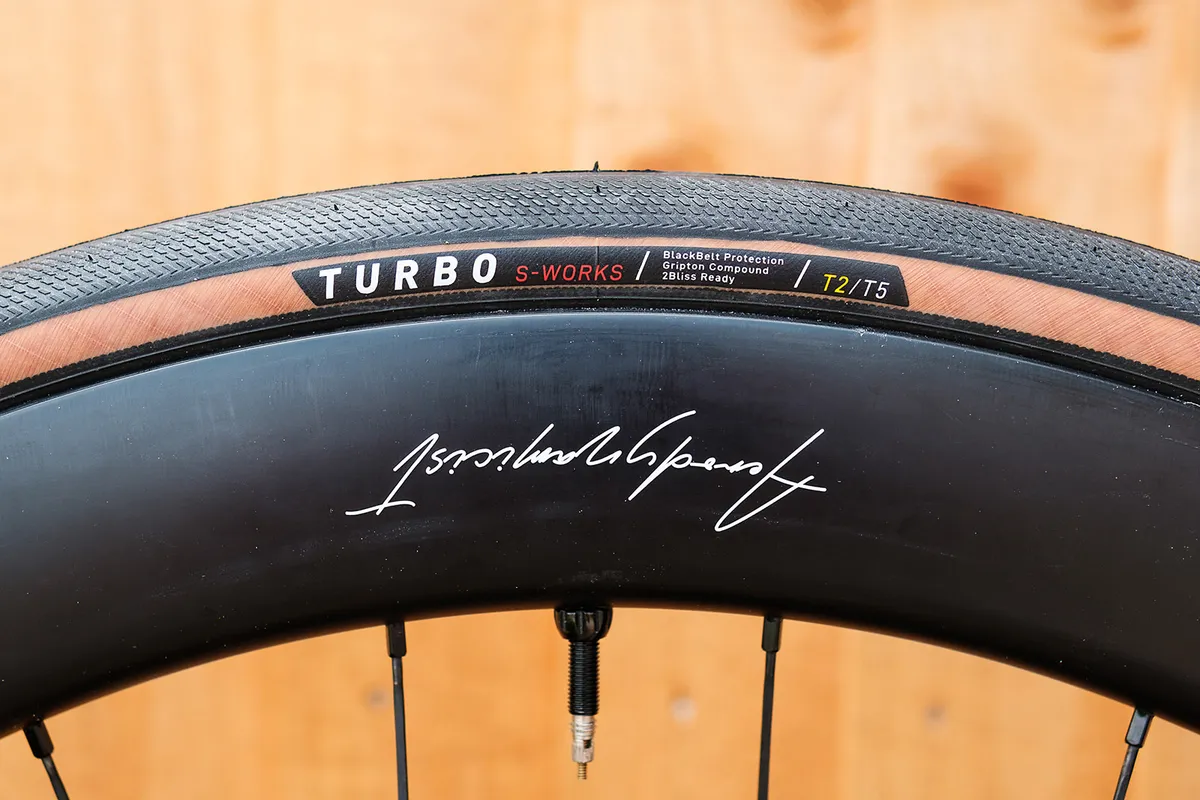
- Price: £55 / $80 / €85 as tested
- Pros: Great value; Fast-riding on rough roads; well-priced
- Cons: Not the most supple
After being lukewarm on road tubeless tyres for a while, Specialized re-entered the arena with the S-Works Turbo 2BR tyre, pitching it as the "fastest, most durable performance tyres" the brand has ever produced.
Real-world speed and grip impressed on the tarmac, while the extra degree of toughness on offer gave us the confidence to take on broken roads and gravel tracks.
In fact, the S-Works Turbo 2BR reminded us of the highly-rated Continental GP5000 S TR – happily, though, the Specialized tyre is a fair bit cheaper.
Specs
Type Tubeless (tested) or clincher | Colour options Black or tan | Size and width options 700x26c, 700x28c, 700x30c | Size tested 700x28c | Weight 285g | TPI 120
SQUIRREL_13082216
Vittoria Corsa N.EXT TLR
SQUIRREL_TEXT_13087028
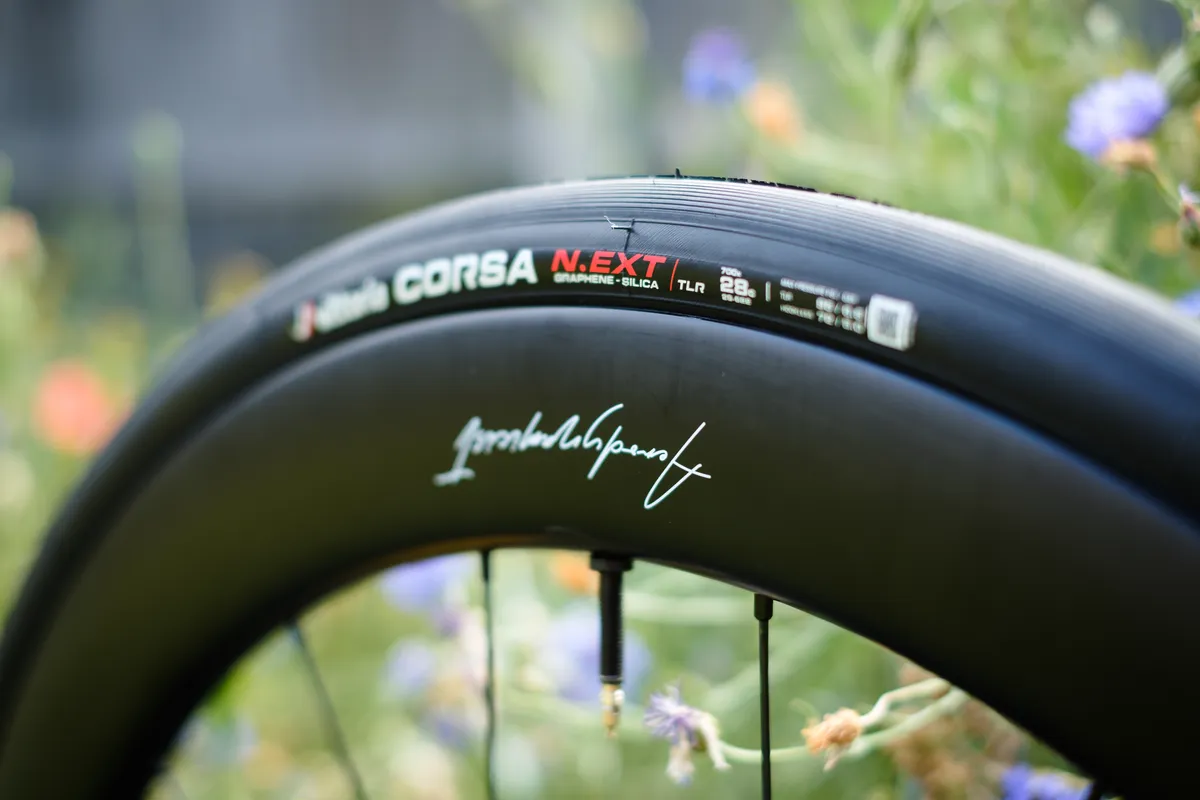
- £64.99 / $84.99 / €69.95 as tested
- Pros: Versatile; decent wear resistance; easy to install
- Cons: Not the fastest
The N.EXT TLR is the first tyre with a nylon, not cotton, casing in Vittoria's Corsa range and warrants its prestigious label.
The second-tier Corsa is all you want from a road tyre, providing grip, wear resistance and decent speed. It's also easy to set up tubeless. Ride quality is high, yet the N.EXT TLR isn't the swiftest tyre in its class.
Tan-wall fans will have to look elsewhere. The N.EXT TLR is available in six widths, but black is the only colour choice.
Specs
Type Tubeless | Colour options Black | Size and width options 700x24c, 700x26c, 700x28c, 700x30c, 700x32c, 700x34c | Size tested 700x28c | Weight 302g | TPI 100
SQUIRREL_13087028
How we test road bike tyres
We test road bike tyres out on the road in their natural environment.
Our testers tally up hundreds of miles when testing road bike tyres to ensure any strengths or weaknesses are discovered and presented in our review.
Ultimately, we base our road bike tyre reviews on the following criteria:
- Grip – how well the tyre keeps traction on the road
- Rolling speed – how fast the tyre rolls and whether it feels zippy
- Durability and longevity – does the tyre hold up to punctures and how fast does it wear?
- Weight – is the tyre especially light?
- Value for money – does the tyre represent a good deal compared to others on the market?
Why you can trust BikeRadar
BikeRadar has been an authority on bikes and cycling tech since its inception in 2007, delivering the world’s best riding advice.
We have experts testing all types of bikes, parts, clothing and accessories, from road, mountain and gravel bikes to commuting, bikepacking and electric bikes.
Our reviews are always editorially independent – with no exceptions. Our reviewers comprehensively test all products in the real world, always reflecting on performance, value and the wider market when delivering their verdicts and review ratings.
We have more than 15,000 product reviews available at your fingertips, as well as expert buying, maintenance, training, skills, health and fitness advice.
Our annual Bike of the Year test is an industry benchmark and the BikeRadar team consists of some of the most experienced riders and testers in the business.
Road bike tyres buyer's guide
Types of road bike tyre
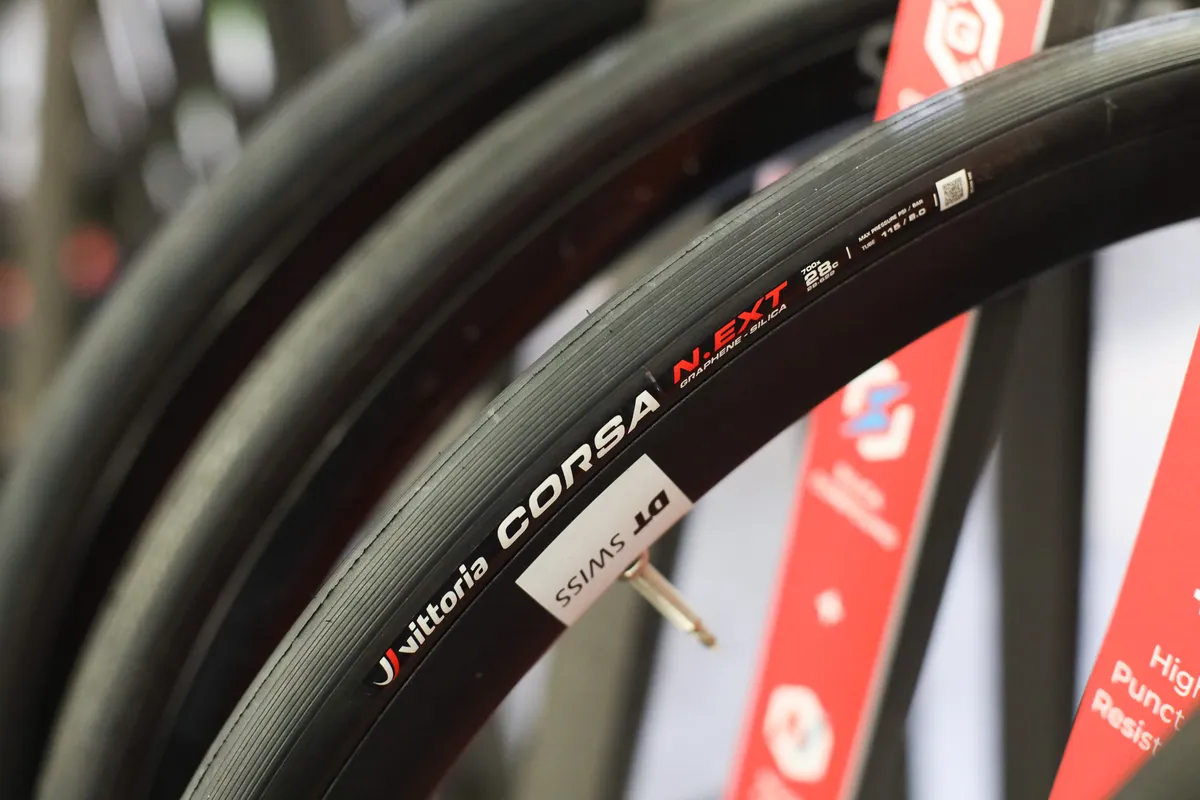
There are three main types of road bike tyre on the market today: clincher, tubeless and tubular.
Clincher tyres, which have an open casing that requires the use of an inner tube, are the most common type on the market. These mount on to standard hooked wheel rims.
Tubeless tyres use a similar open casing construction as clincher tyres but, as the name implies, can be used without inner tubes on specially designed, tubeless-compatible rims.
This buyer's guide contains our favourite tyres, regardless of type, but head this way if you want a separate list of the best tubeless tyres.
Tubular tyres use a tubular casing that is sewn shut around an inner tube. The tyre is then glued on to a tubular-specific rim, which doesn’t have sidewalls or bead hooks. Tubular tyres are historically popular with professional cyclists, but are rarely used by amateurs.
Tyre sizes
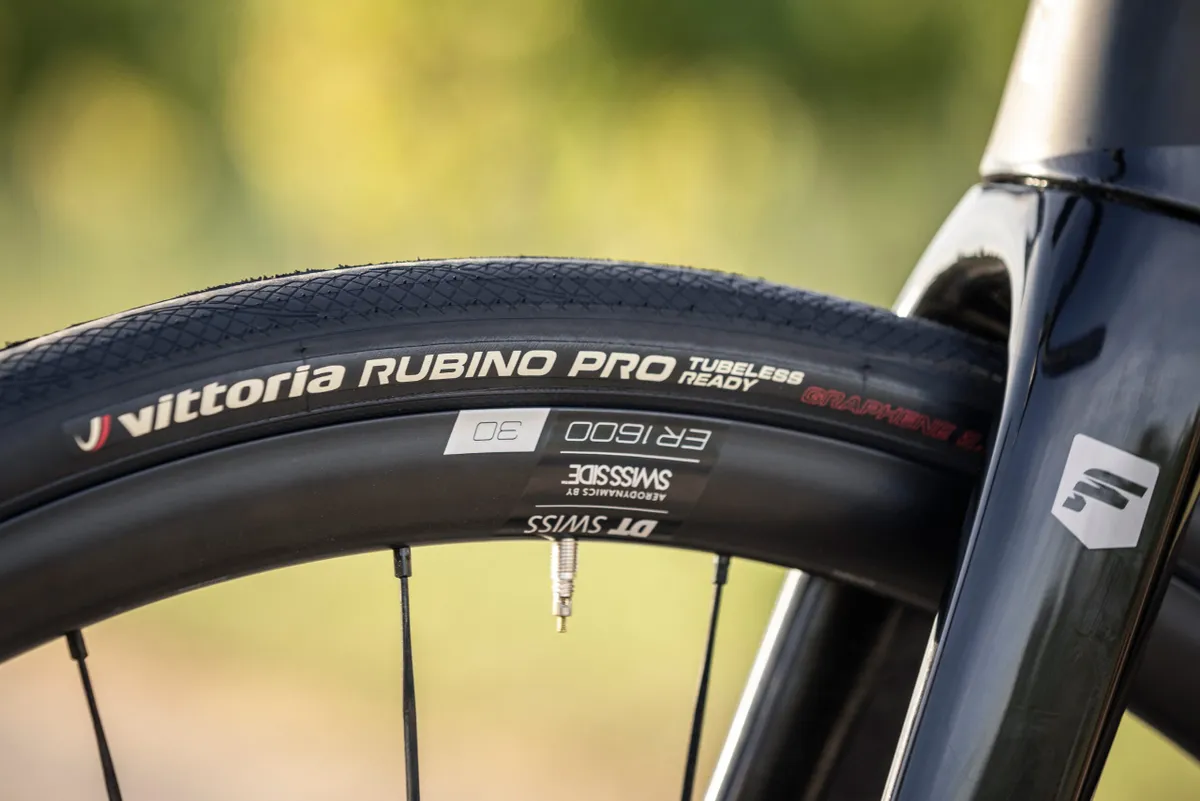
You’ll see numbers such as 700 x 25mm quoted many times below. This refers to the size of the tyre.
700c tyres mount on to 700c wheels, which is the most common size for road bikes (we've got a buyer's guide on the best road bike wheels).
If you have a very small road bike or a gravel bike, you may have 650b wheels, with a smaller diameter, in which case you’ll need a 650b tyre. Our round-up of the best gravel bike tyres covers both 700c and 650b options for multi-terrain riding.
For mountain bikes, it’s a bit more complicated because there are a number of different wheel sizes, though these days most MTBs use either 27.5in (i.e. 650b) or 29in wheels. Head to our guide to the best mountain bike tyres for more.
The second number refers to the width of the tyre in millimetres once it’s inflated (though the width of the rim a tyre is mounted on also affects the inflated size, so this is more of a guide).
If you’re looking at buying road bike tyres larger than 25mm, you’ll need to check that your frame and fork both have adequate clearance.
Until recently, most road bikes only had clearance for 25mm tyres, so unless you’ve got a relatively new bike, it’s sadly not a given you’ll be able to upgrade to a 28mm tyre or larger.
If your road bike is relatively new – and especially if it has road disc brakes – then you'll likely be able to fit a 28mm tyre or larger.
What is TPI?

TPI refers to ‘threads per inch’ and indicates how many individual threads of woven nylon or cotton cross through one square inch of a single ply of the tyre's casing.
Lower TPI casings use fewer, thicker threads, whereas higher TPI casings use a greater number of thinner threads.
Generally, higher TPI tyre casings offer a more supple, comfortable ride feel and deliver lower rolling resistance.
There’s no such thing as a free lunch though, because these tyres are usually more delicate and prone to punctures than tyres with lower TPI casings.
Casing construction is also only one part of the equation in determining the overall rolling resistance of a tyre.
What is rolling resistance?
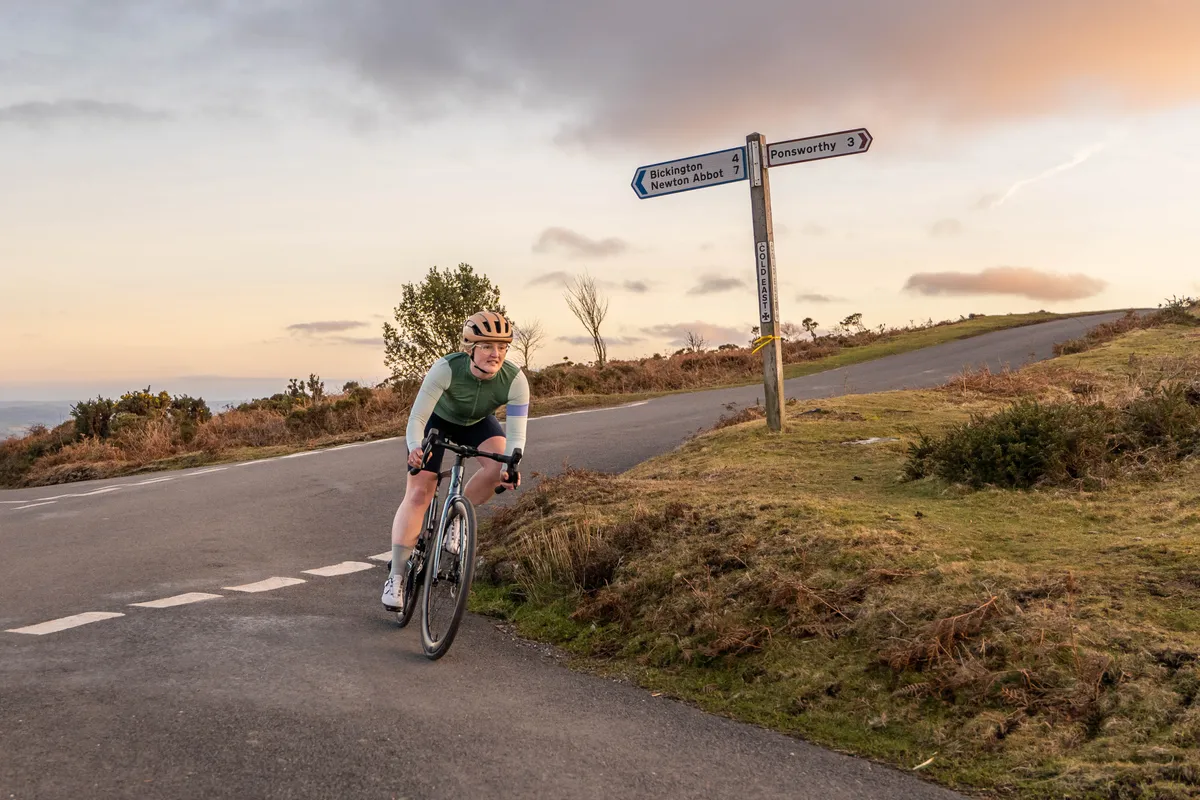
Rolling resistance, sometimes referred to as ‘Crr’ (coefficient of rolling resistance), is the energy lost as a tyre rolls across a surface.
On hard surfaces, such as roads, losses can mainly be attributed to deformation of the tyre (hysteresis) and friction between the road surface and the tyre tread.
There are a number of factors that determine a tyre’s rolling resistance, including construction, the rubber compound used for the tread, inflation pressure, the width of the tyre and the tread.
We’ll take a deeper dive into this subject in the buyer’s guide at the end of the article because it’s quite a complicated subject.
Generally though, for road use, you want a slick tyre (or a tyre with minimal tread) with a flexible casing, inflated to a high (but not too high) pressure.
What should you look for in a tyre?
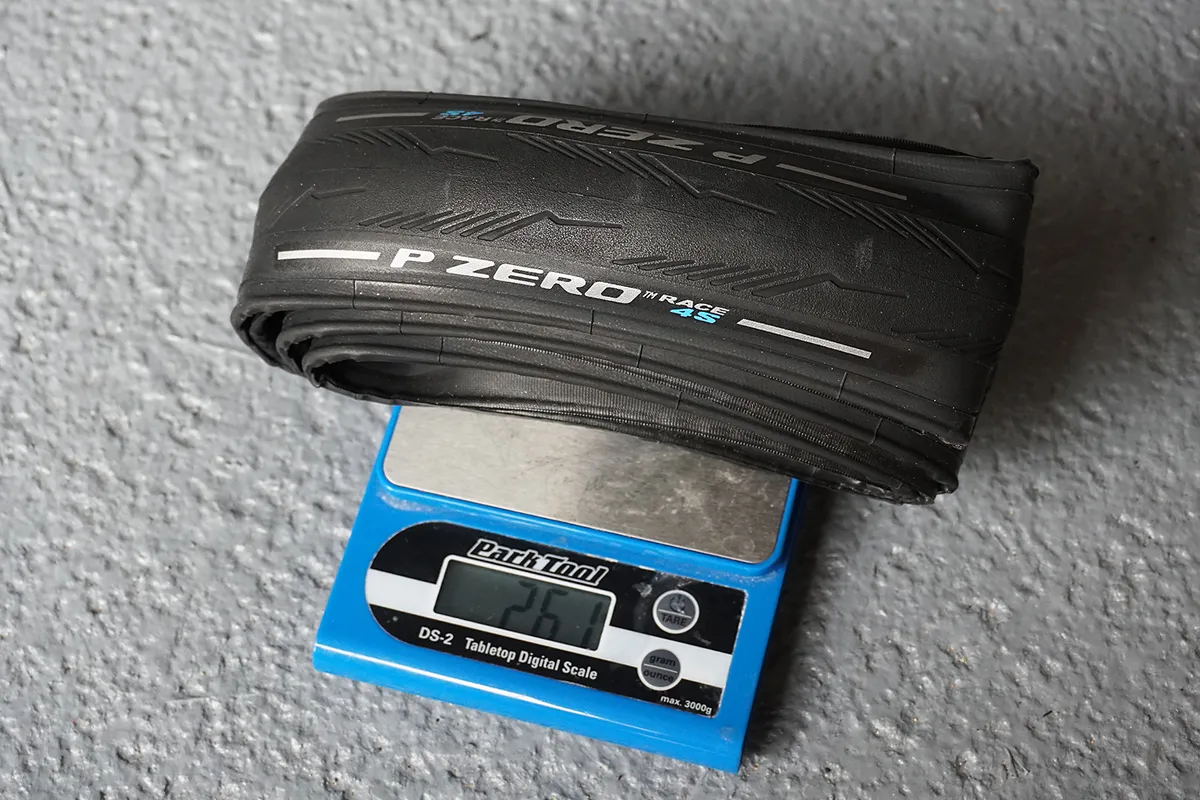
The ultimate bike tyre would be super-light, totally resistant to punctures and fast. Unfortunately, that tyre doesn't exist and so you generally have to make do with two of these three attributes.
Your predominant type of riding should ultimately dictate your tyre choice. For example, if most of your time is spent heading out on gravel backroads or commuting on rough inner-city roads, you'll be better off with a tyre that's geared towards puncture protection over speed and weight.
On the other hand, if you often ride on good roads that are smooth, debris-free and dry, then some lightweight, racy tyres can be a great choice.
You can find out where most tyres sit in the weight / puncture protection / rolling resistance triangle by checking their packaging or the manufacturer's website. And, of course, our reviews will let you know how those claims stack up in the real world.
Types of tyre
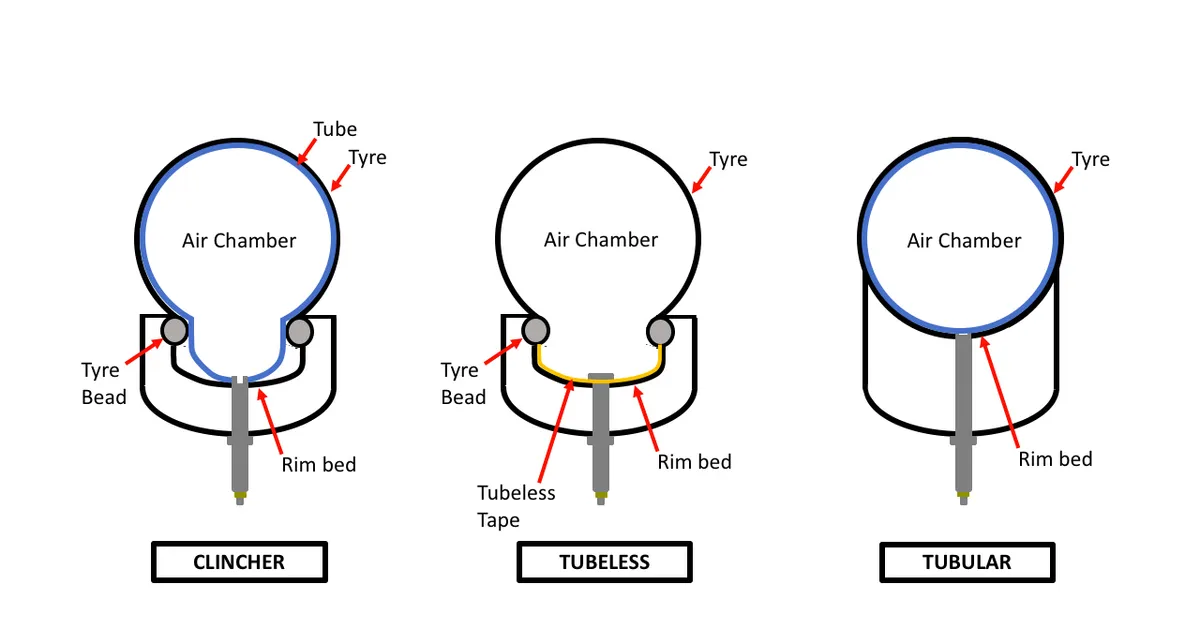
Tyres for road bikes come in three styles: clincher, tubeless and tubular.
Clincher tyres
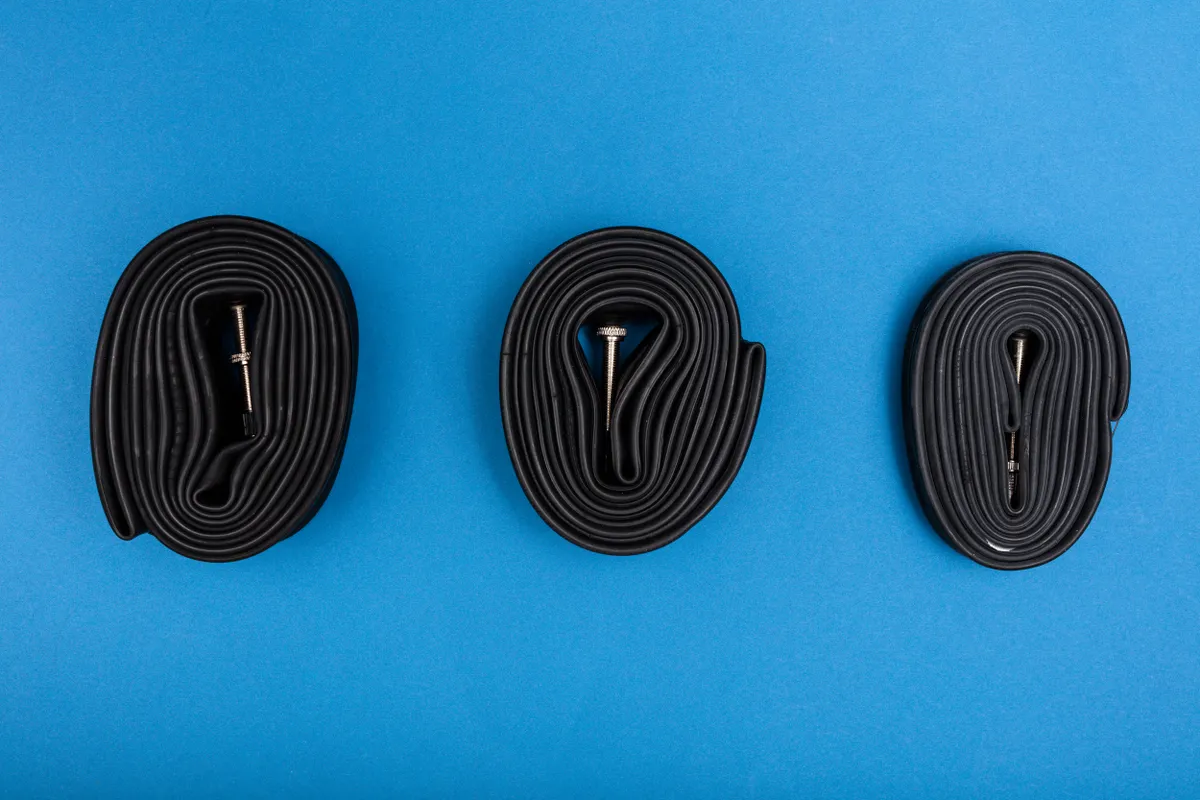
Clinchers are the most common type of tyres found on road bikes. They have an open casing that houses a separate inner tube and is held on the wheel by the rim bead hooks.
The main advantage of clinchers is that they make fixing a flat easy because all you have to do to get at the punctured tube is prise off one side of the tyre. This usually requires a tyre lever or two, but with some tyres you can do it with just your thumbs.
There are two types of clinchers: folding and non-folding. The difference is in the material used to make the bead (the part that hooks onto the rim).
Folding clinchers generally use Kevlar, a durable material that – as the name suggests – allows the tyres to be folded. Non-folding clinchers use a bead made from steel wire and can't be folded.
Folding clinchers are more expensive, but they're also lighter and are easier to get on and off a rim. The fact that they fold isn't really important as far as riding is concerned, but it does usually mean such tyres have slightly lower levels of rolling resistance.
Tubeless tyres
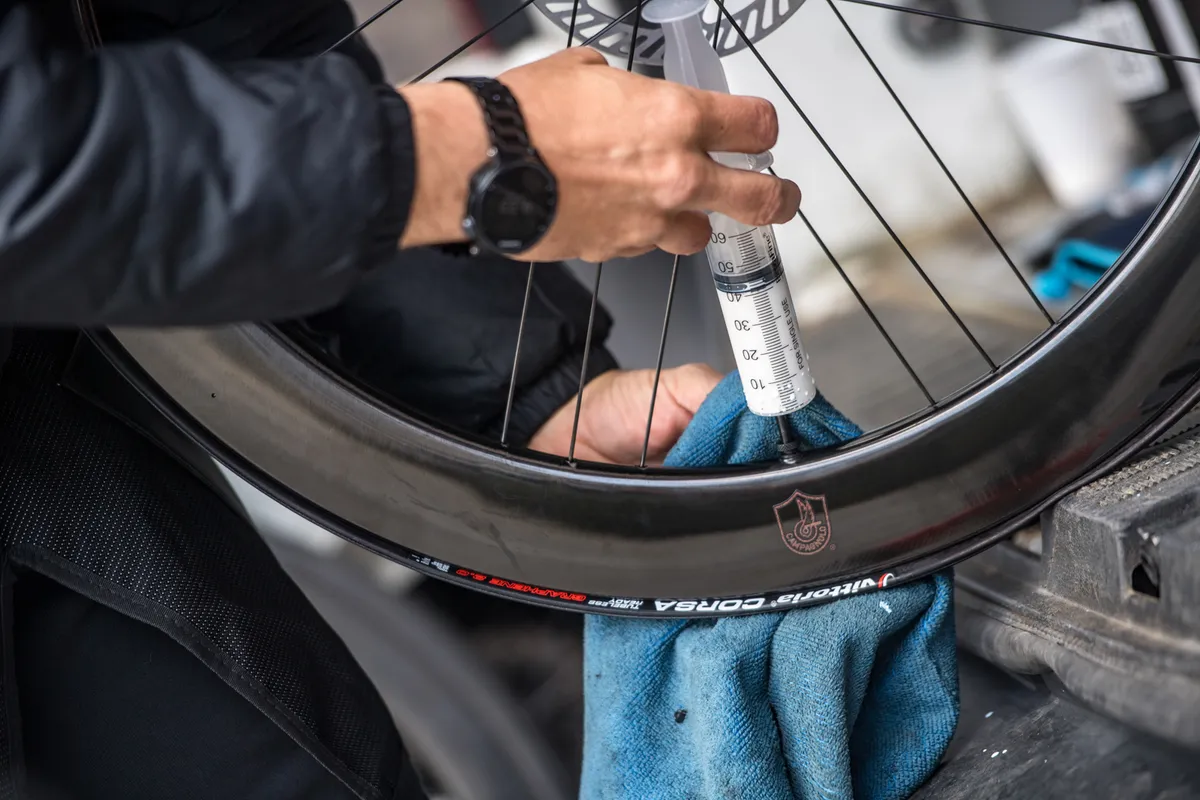
Tubeless tyres have been a mainstay in the mountain biking world for some time and they've now come to road cycling.
As the name suggests, tubeless tyres don’t use an inner tube. They're very similar to standard clinchers except that the tyre and rim seal together to become airtight and remain inflated, just like the tyres on most modern cars.
Such an airtight seal can't be achieved with any old rim and tyre though. A tubeless setup not only requires tubeless-specific tyres (which have a special stretch-resistant tyre bead) and rims but also a special valve, viscous liquid sealant and special rim tape.
The idea is that removing the inner tube from the equation reduces weight and rolling resistance, and, without said inner tube, you can also run lower tyre pressures without the fear of a pinch flat, meaning a more comfortable ride and more grip.
The addition of the tubeless sealant can help eliminate punctures from small, sharp objects.
This is particularly welcome on tyres designed for going off-road and delicate racing tyres such as the Schwalbe Pro One TT and Vittoria Corsa Speed, which use thin casings and eschew puncture protection strips in order to reduce rolling resistance to the absolute minimum.
If the puncture hole can't be sealed by sealant alone (because it's too large, for example), you still have the option of fitting an inner tube, or there are 'tyre worm' tubeless repair kits such as Stan's NoTubes DART.
Tubeless tyres aren’t a panacea, however. In order to aid air retention, manufacturers sometimes have to make the tyre casing thicker and heavier than on a standard clincher tyre, which can dull ride feel and increase rolling resistance.
They can also be far more difficult to install if you get a rim and tyre combination that doesn't play nice, and you may also need an air compressor or special 'flash' pump to properly seat the tyre bead.
Much of the bike industry, and particularly wheel and tyre manufacturers, are convinced tubeless is the future for road cycling, though. In fact, it's quite unusual to see a new tyre or wheelset without tubeless compatibility these days.
Some brands are even beginning to release hookless rims for road use, on which the bead hooks have been eliminated. This means compatibility is limited to tubeless tyres only because standard clincher tyres (which have much stretchier tyre beads) require the bead hooks to prevent them from blowing off the rim when inflated.
Tubular tyres
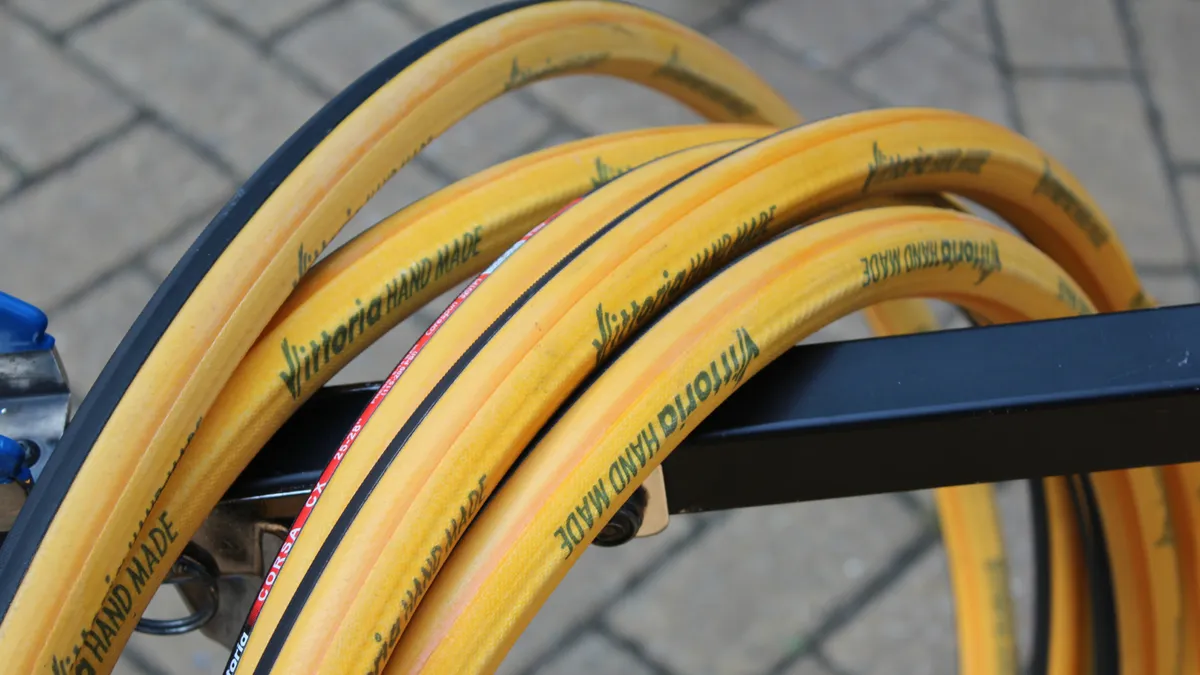
Historically, pro riders have used tubular tyres for racing, though that is beginning to change with the growing popularity of tubeless.
With tubeless technology now beginning to gain prominence in both the pro peloton and with everyday riders, expect tubulars to become even more marginalised.
However, it's still worth us recapping on the potential advantages and disadvantages of tubulars.
Tubulars still rely on an inner tube but, instead of the casing being open, like on a clincher, it's sewn shut around the inner tube, so that the pairing takes on a tubular form – hence the name.
The tyre then has to be glued (or taped using special double-sided tape) onto a rim specifically made for tubular tyres.
Unlike rims designed for clinchers, tubular rims don’t have bead hooks inside the sidewalls for a tyre to clinch onto. Tubulars rely on tyre pressure and glue to hold them on the rim.
Some riders still swear by tubular tyres, claiming they offer a superior 'feel'. This can largely be attributed to the fact that until recent years, many tyre manufacturers only released their fastest tyres in tubular form.
Tubular tyres also tend to have slightly higher rolling resistance than an equivalent clincher because of frictional losses in the glue.
But the big, tangible advantage to tubular systems for road use is that the equivalent tubular rims can be made much lighter than a clincher or tubeless-ready rim. This makes them extremely popular with weight weenies and hill climb obsessives.
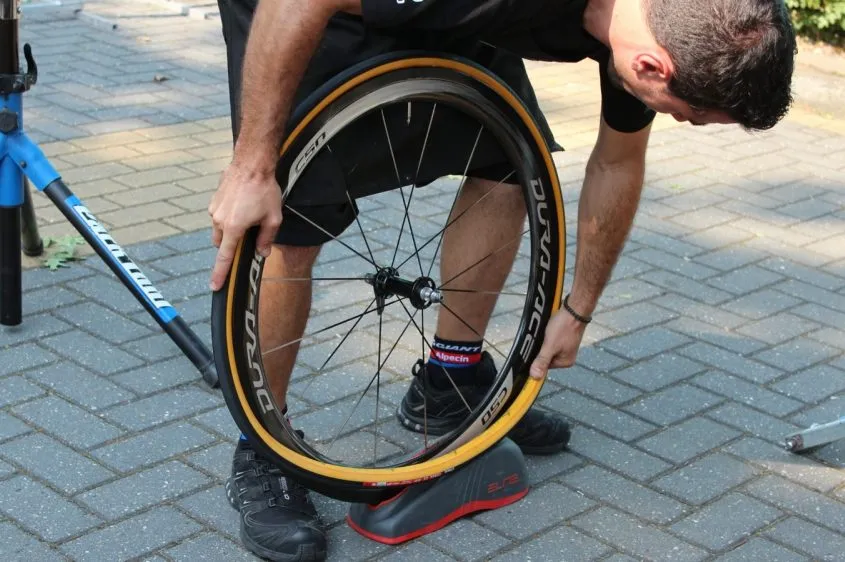
A second, more esoteric advantage is that tubular tyres can still be ridden when punctured. This is because they won't separate from the rim, unlike clinchers, meaning a rider may be able to continue riding until the punctured wheel can be changed.
Tubulars are also said to be more resistant to 'pinch flats', where the inner tube is pinched between the rim and tyre, usually caused by hitting a sharp-edged obstacle such as a pothole. This is probably more a function of the tendency to run tubulars at higher pressures than their construction, though.
The disadvantages of tubulars – which tend to be felt much more keenly by regular cyclists than the pros with team mechanics – are that having to glue tyres to the rim makes the initial installation laborious (although tubular tape arguably eases this issue) and sorting a puncture during a ride can be very difficult.
Your two options are using a CO2 inflator cartridge containing sealant and hoping it can seal the hole, or tearing off the punctured tubular and replacing it with another, which obviously means riding with a spare (actually repairing a punctured tubular, rather than simply replacing it, means breaking out the sewing kit).
You can – very carefully – ride home on a spare tubular stretched over a rim, but you must glue this new tubular in place before your next ride.
Gluing a tubular is no piece of cake either. It requires attention to detail and plenty of patience because a bad job can result in the tyre rolling off the rim, likely causing a dangerous crash.
Rolling resistance continued…
As already noted at the beginning of this article, there are a lot of factors that determine the rolling resistance of a tyre. Let’s explore those in more detail.
Tyre construction
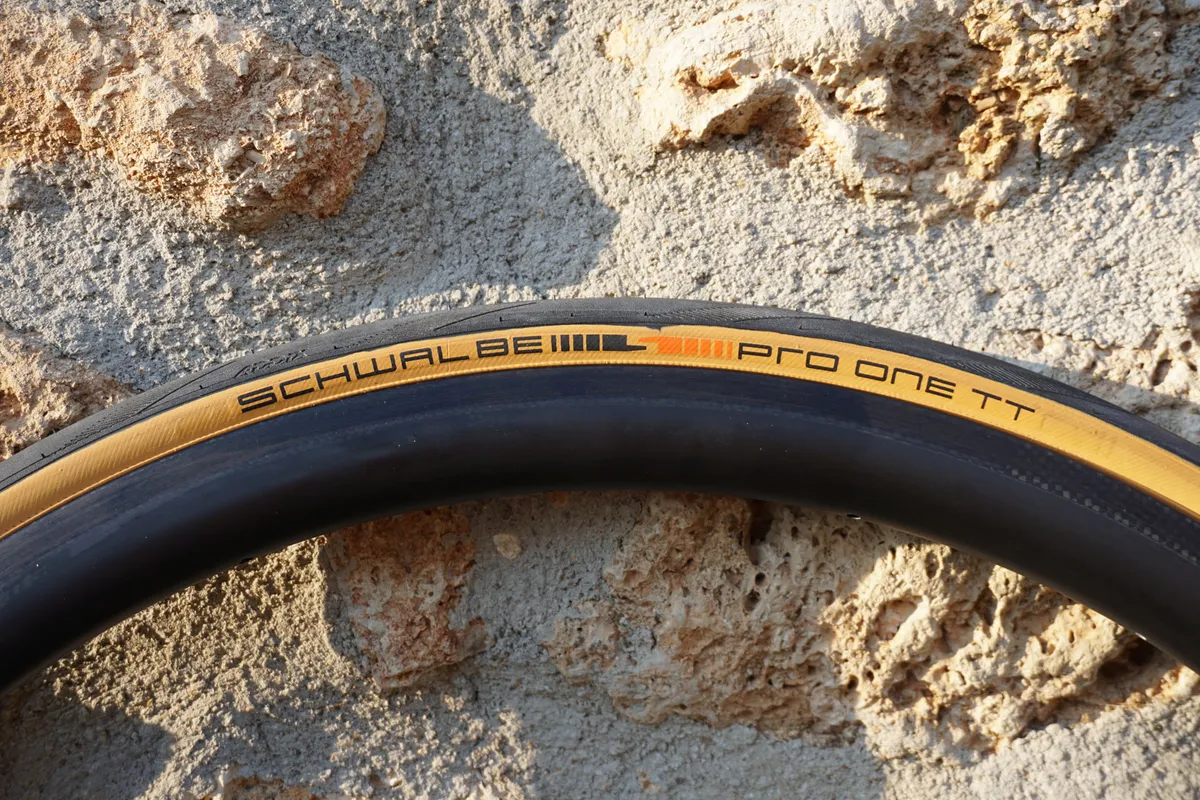
Tyres with thinner treads and higher TPI casings tend to be more supple, and thus require less energy to deform. This in turn means less energy is lost to hysteresis, which decreases rolling resistance.
The exact recipe of the rubber compound used in the tyre's tread makes a large difference too. Additives such as silica or graphene are used to reduce losses to friction and hysteresis, but each manufacturer guards its own exact recipe very carefully.
Increasing the thickness of the rubber tread or adding puncture protection strips or layers can also affect rolling resistance by increasing the amount of energy required to deform the tyre.
The fastest tyres combine supple casings, thin treads and low-friction rubber compounds. The downsides to these tyres though are usually significantly decreased puncture protection and service life.
Tyres that use thicker treads on stiffer casings will be slower, but you’ll generally also get better puncture protection and service life.
For this reason, many riders will switch to tyres such as the Continental Gatorskin or Schwalbe Durano during the winter, when the increased rolling resistance is less of a concern than the prospect of having to fix punctures with cold hands.
It’s a well worn cliché, but it’s also true that nothing is slower than a puncture. Time trial tyres are unlikely to be the best choice for training, long-distance sportives or commuting. Choose tyres that have the right balance of characteristics for your personal riding needs.
Tyre width
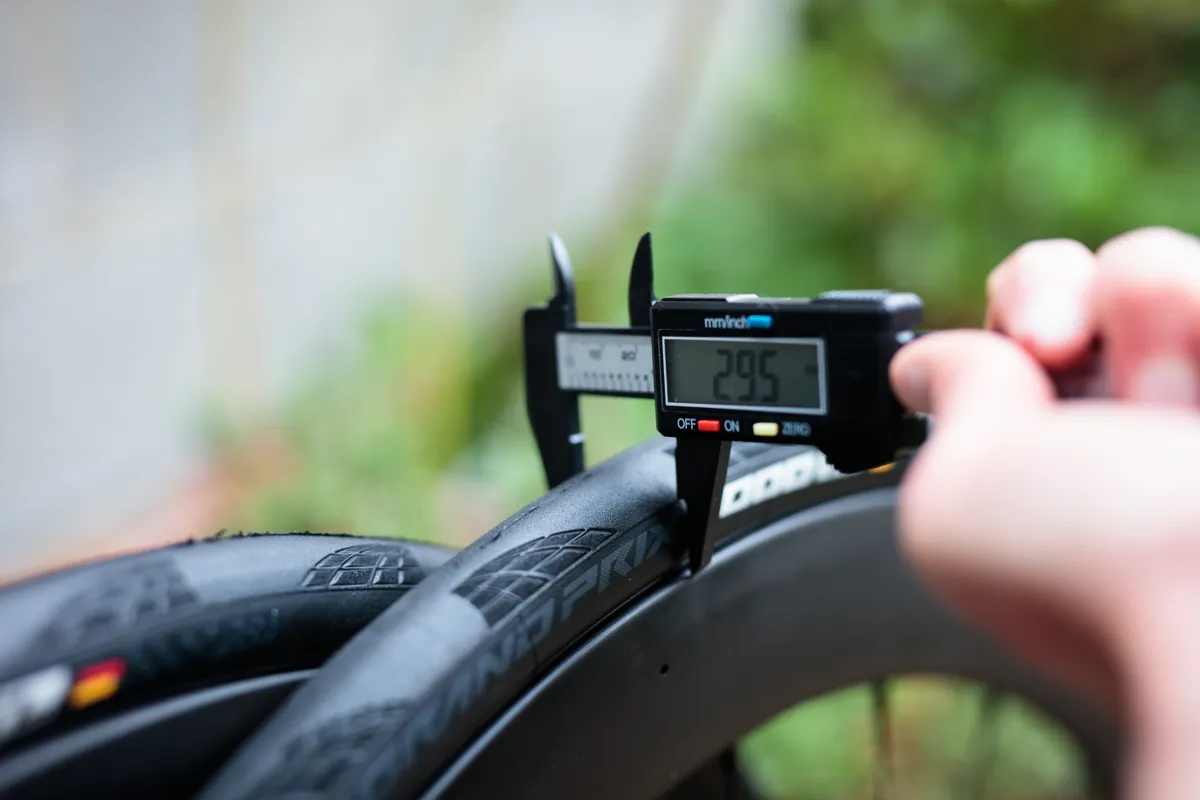
The main thing you need to know is that, for most people, wider tyres are generally faster and more comfortable.
This is because, at the same pressure, wider tyres have a shorter contact patch with the road than narrow tyres and this decreases the deformation of the tyre, which decreases rolling resistance.
Of course, in the real world, we tend to run wider tyres at lower pressures than narrow ones, which can cancel out that rolling resistance advantage, but you also get increased comfort and grip with the wider tyre, which makes a big difference to how fast you can ride on imperfect roads.
The only downsides are that wider tyres increase weight and aerodynamic drag slightly, meaning they require a little more energy to accelerate and push through the air. The benefits of wider tyres outweigh these marginal losses at the speeds most of us ride, though.
The tables only really turn at the higher speeds seen in time trials or on the track (because the faster you ride, the more aerodynamics matter), but with modern wheels now designed around 25mm or wider tyres, there’s very little reason to choose 23mm or narrower tyres anymore.
Tyre pressure
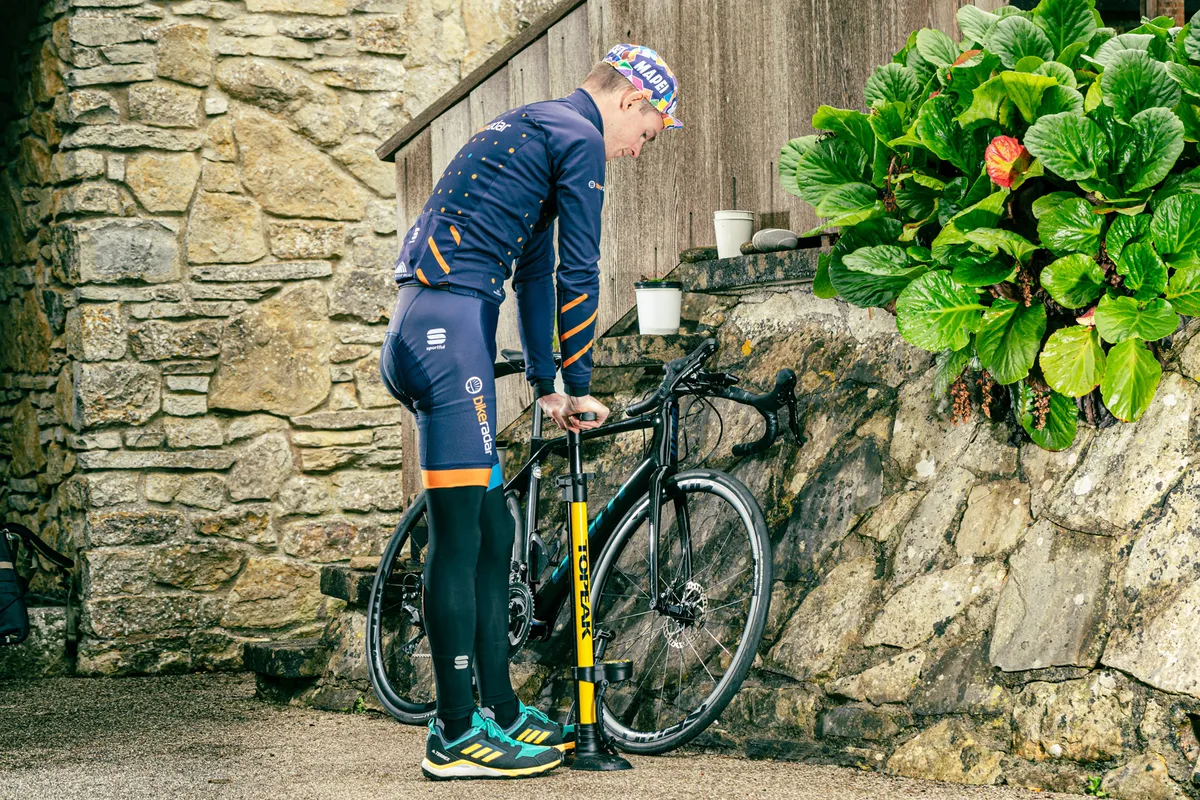
We've got a full guide to optimising road bike tyre pressure, but let's cover the basics here.
On a perfectly smooth surface, like rollers or an indoor track, higher pressures mean less tyre deformation and therefore lower rolling resistance.
As most people know all too well, in the real world the roads we actually ride on are not perfectly smooth. In fact, if you were to look very closely, even the smoothest road is actually full of small holes, bumps and imperfections.
Because of this, tyres run at too high pressures have a tendency to bounce over the road surface. This may feel fast, but it’s actually slowing you down because the energy you’re putting through the pedals isn’t contributing to driving the bike forward when the tyre isn’t in contact with the ground.
Lowering your tyre pressure enables the tyre to act as a kind of suspension system, keeping your rubber in contact with the road more of the time and wasting less of your energy input.
The key to tyre pressure is finding the right balance between having it high enough to minimise tyre deformation but low enough to absorb the vibrations and keep the rubber in contact with the surface you're riding on.
Unfortunately, there's no hard and fast rule for what pressure this will be for you because, just like mountain bike tyre pressures, it depends on myriad factors such as what kinds of terrain you ride on, what wheels and tyres you're using and how much you weigh.
The best advice we can offer is to follow the manufacturer's recommendations, experiment with different pressures and err on the side of being slightly too low instead of slightly too high. That way you'll at least be more comfortable and have more grip.
Inner tubes and tubeless
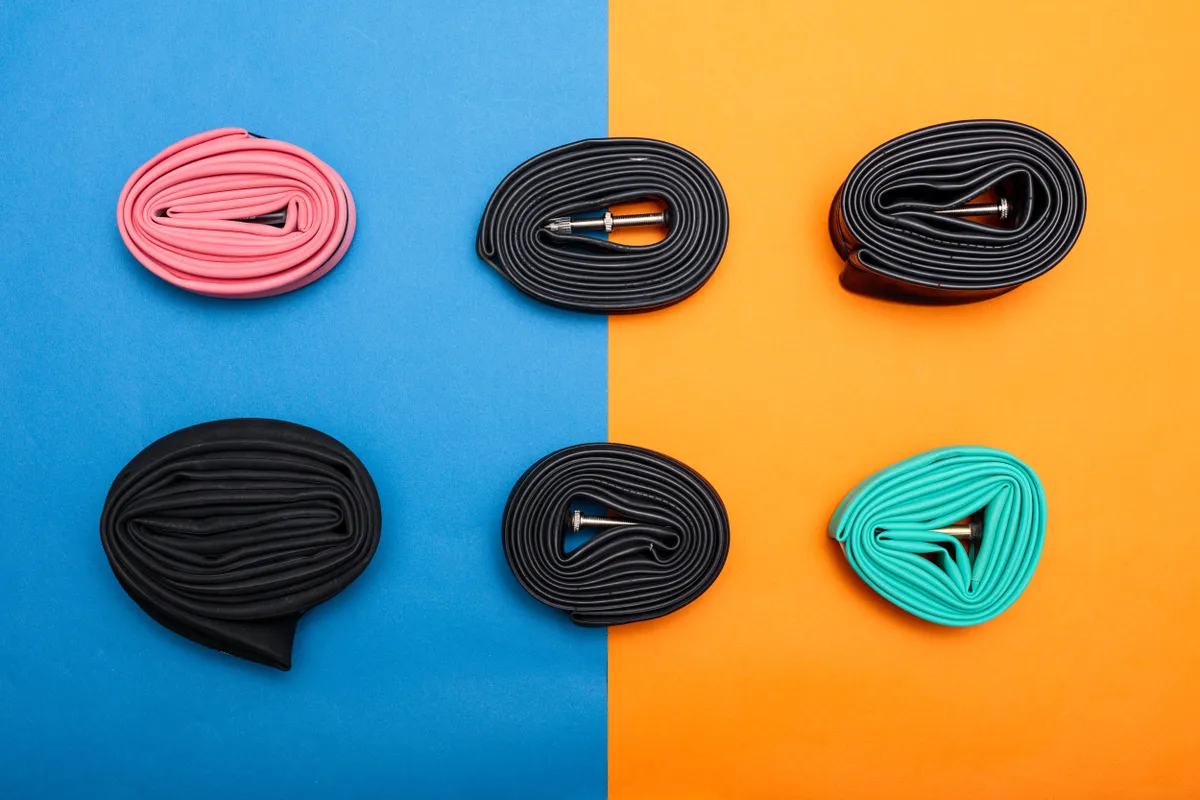
The inner tubes in a clincher or tubular system are also the source of some frictional and hysteresis losses.
Thinner, lighter inner tubes generally contribute less to rolling resistance because there is less material to deform, meaning they’re more flexible.
Latex inner tubes, though more expensive than standard butyl inner tubes, offer even less rolling resistance because latex is more supple than butyl and requires less energy to deform.
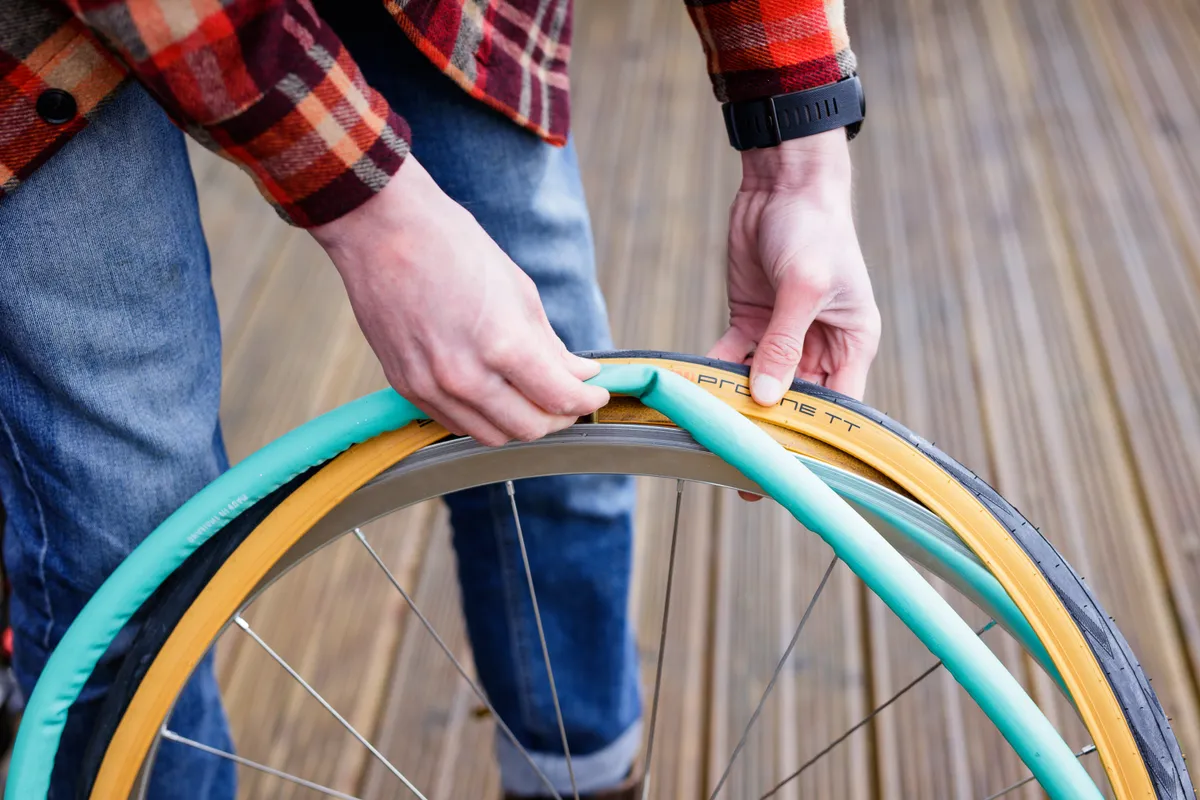
Tubeless systems offer reduced rolling resistance by eliminating the inner tube altogether.
However, it’s not as simple as saying ‘tubeless is therefore faster’ because tubeless tyres often have more material added to the tyre itself to make it airtight, which can increase the rolling resistance of the tyre compared to an equivalent clincher.
The amount of sealant added to a tubeless tyre system has also been shown to affect rolling resistance (adding more sealant than you need increases rolling resistance), so we’d always recommend following the manufacturer's instructions.
Anatomy of a tyre
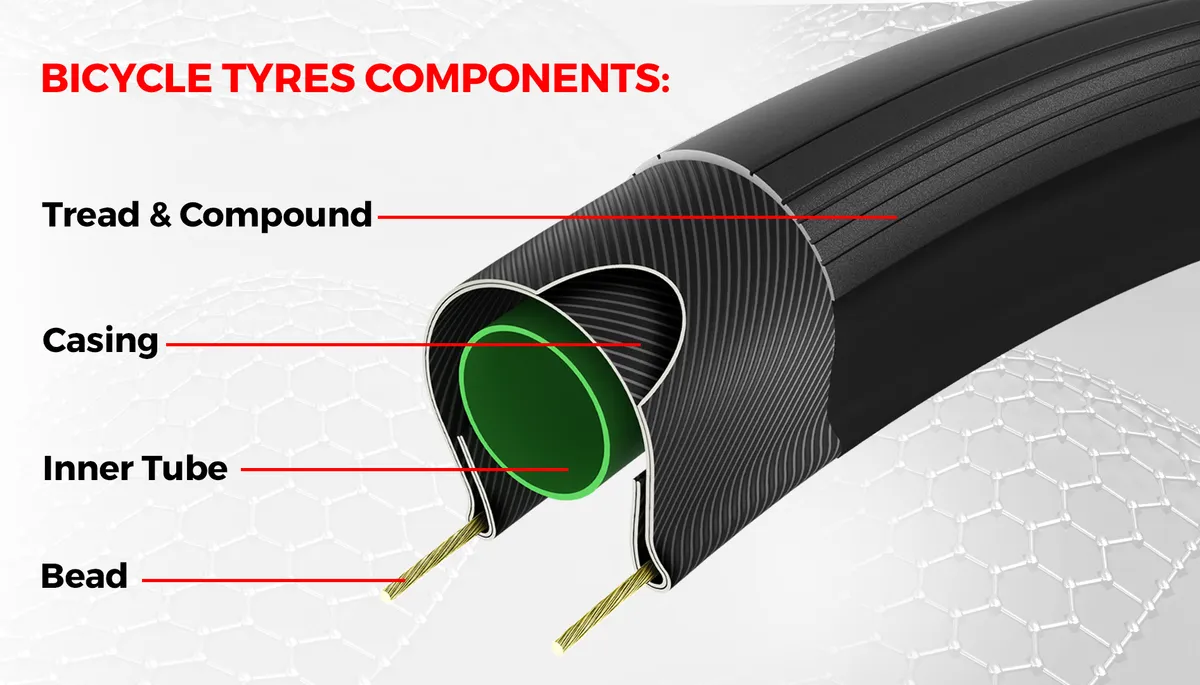
- Bead: This is what holds clincher and tubeless tyres on the wheel rim. The air pressure inside the tyre pushes the beads out, making them hook onto the rim. Wheels with hookless rims require the use of tyres with a tubeless-specific bead because standard clincher tyre beads may stretch off the rim when inflated, leading to a potentially dangerous blowout.
- Casing: This is cloth fabric 'woven' around the beads that creates the main body of the tyre. While the vast majority use nylon fabric, higher-end tyres may use cotton or silk. The casing has a major effect on ride quality because of the threads per inch (TPI) value. Tyres with a low TPI will have thicker threads, which cause greater rolling resistance but make the tyre more resistant to punctures. Meanwhile, tyres with a high TPI use finer threads for less rolling resistance and lower weight, but will be more susceptible to punctures.
- Sidewall: Rubber is applied to the side of the casing between the tread and the bead to form the sidewall. Each tyre will have different rubber compounds and thickness depending on its intended purpose.
- Sub-tread: Some tyres will have a sub-tread layer to fend off punctures. Cheaper tyres may just have an additional layer of rubber beneath the tread, while those at the higher end of the price range will have specially designed fabric strips. These have an unfortunate side effect of increasing rolling resistance, so are often left out of tyres designed specifically for time trials.
- Tread: This is the rubber that comes into contact with the road. It's thicker than the sidewall and sometimes features a three-dimensional pattern. Tread pattern is a hotly debated issue, with many claiming that road bike tyres have no need for tread. However, according to Finnish outfit Wheel Energy, because the texture of any road surface is so varied, some tread patterns provide a measurable mechanical adhesion to the ground. Recent testing even shows that tread pattern can affect the aerodynamic performance of tyres too. The rubber compounds used for different tyres are a closely guarded secret. Generally, softer compounds will offer superior traction but will wear quickly, while harder compounds will stand up to more abuse but won’t have the same grip.
How often should you replace your tyres?
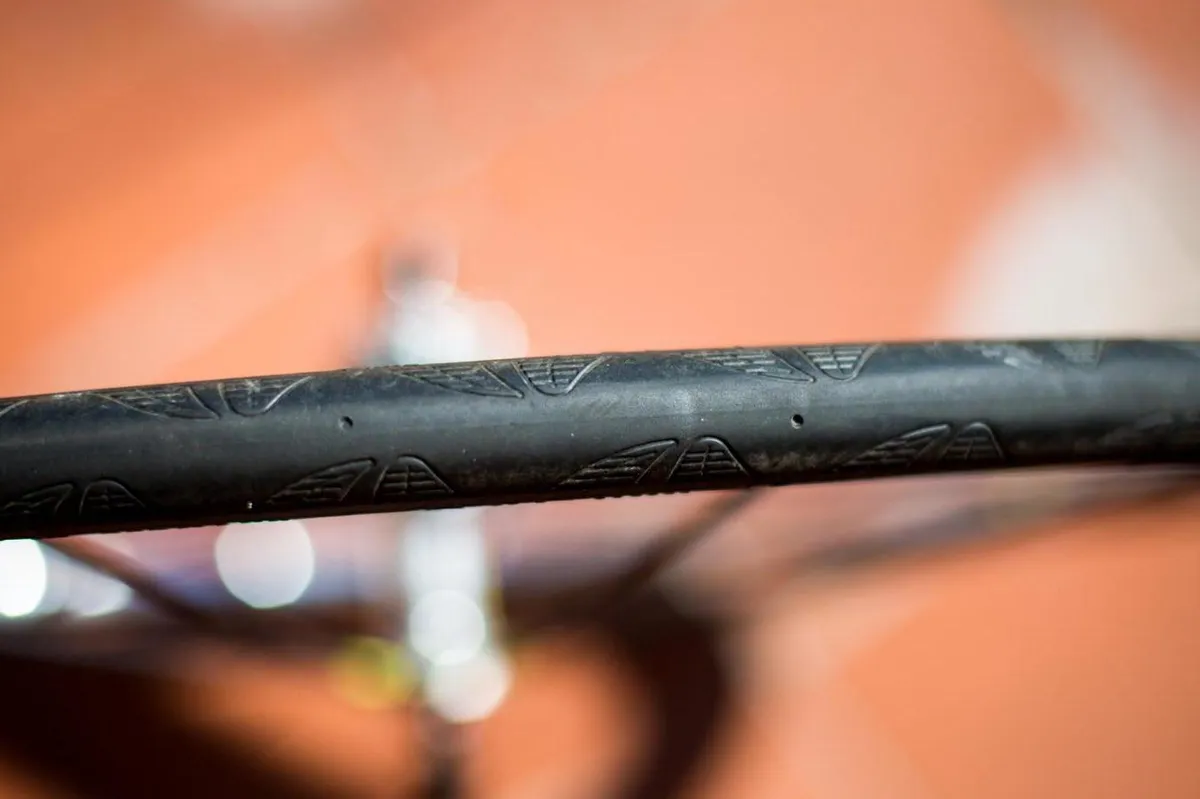
There's no hard and fast rule for deciding when to replace a tyre.
Some have wear indicators – usually a dot or groove in the tread that will wear away over the life of the tyre. In most cases, these indicators offer a pretty good sign of how much life remains in your tyres, but they’re not perfect.
For tyres that don’t have these markers, keep an eye out for gashes and cuts in the tread and sidewalls, ‘squared off' tread or a flat section in the middle of the tyre, or any odd lumps or bulging.
If cuts and gashes are so deep that you can see the casing fabric underneath, or you’re repeatedly suffering flats, it’s time for a new tyre.
